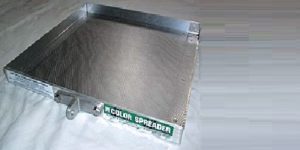Hang up the phone if you are one of the many decorative concretists that are about to embark on any form of colored concrete. If you are somewhat new to the whole coloring thing, please give this article a close look. The progression of improvement in the coloring biz has turned yet another corner in the simplification of the process. Take it from a concrete guy that has spent years throwing color or praying that ready-mix drivers can count bags and talk on cell phones at the same time. The complexity of coloring the concrete surface has made a natural progression towards being more user-friendly, accurate, affordable and durable.
For years now I couldn’t help but think that there had to be a better way to achieve vibrant colors without killing myself and my crew with broadcast-style color hardeners. I vividly remember thinking that someday cement masons would simply spray on color and eliminate this thankless task of coloring the concrete surface. I didn’t know it at the time, but I was right — well, kind of. I’m getting ahead of myself, so let me explain.
Up to this point, coloring concrete was pretty much done with one of two methods: dry-shake color hardeners and integrally colored concrete. I’m betting most of you know the difference between the two, so I won’t take up much space explaining the differences. Color hardeners are broadcast across the wet concrete surface and create endless color options. Integral coloring is usually done at the ready-mix plant and colors the entire load of concrete. Integral colors are limited but have a huge place in the decorative concrete industry. It is rare, but sometimes my crew will use integrally colored concrete for one reason or another.
Most decorative crews will use the (dry-shake) color hardener method because it’s accurate, more affordable, and produces crisper lines in the pattern. This process adds another step to the finish and stamping procedure, but the benefits have far outweighed the drawbacks, at least up to now. The problem is that this step has a huge learning curve and can be extremely timing-sensitive. Lately I have found myself questioning why we color the way we do. I guess I’m just kind of an outside-the-box type, but see if this makes sense to you. If you could stamp and color quality jobs while making it easier for your crew and saving your client money, than why not?
The epicenter of all this is the new and user-friendly stains that are now available.
The stamp and stain process
This stamp-and-stain process is not entirely new, because fellows have been stamping and then acid-staining to highlight for years. This is not the process I’m promoting. The process I’m talking of consists of not coloring the concrete at all during the stamp or color process. Natural gray concrete is simply finished as usual or stamped with the use of a clear liquid release agent.
The concrete is left to cure to the point when you would usually apply your sealer — but this is where the staining comes in. The next step would be to thoroughly clean the surface and apply a solid base-color stain. If the surface is imprinted, then another highlight color or colors could soon follow. The final effect and look is the same as a colored surface or as a stamped surface if imprinted. Think of the risk this eliminates if your project requires multiple pours across several days. The new stain products and procedure I’m talking of have a sealer in them, so this will eliminate the normal sealing process. The end result is less time, less money, and less headache.
You may be asking, and I would be, how much time and money this saves. My figures are showing somewhere in the neighborhood of 10 percent to 20 percent of your material and labor costs. These figures are broad, and your cost will vary depending on availability, number of steps and efficiency. Regardless, it will simplify the coloring or stamping process, and few will argue this point, I’m sure.
This coloring type offers flexibility with coloring options. It will also leave you the option to completely recolor in the future with little cost and no troubles if your client decides on a color change. Remember, this is all about the customer. If the customer wins, then all of us in the decorative concrete industry win.
A field example
Our office recently had a client call for more stamped concrete that would connect to a stamped patio my company installed almost eight years ago. The problem was that originally, the landscape contractor picked the color — integral — from a pallet of leftover color bags stored at the local ready-mix plant. We were simply given the pattern of choice and a release color in the terra cotta family. I knew this concrete would never be matchable, regardless of who installed it.
Our company put on their thinking caps, because I can assure you no contractor wants to turn down work, at least not in this market. The idea was simple. Our crew would stamp the new concrete by not adding any color of any kind. The new concrete would be allowed to cure and then both the new and old stamped concrete would be stained to insure 100 percent color consistency between the two. This became a true “win” situation that would not have been possible before.
This same idea could be used on all types of decorative finishes, stamped or not. The possibilities are endless, and I’m sure some of you will take this to a level far beyond what I’m describing. This magazine is 100 percent committed to improving our great industry as well as your business, so let us know how this works for you.















